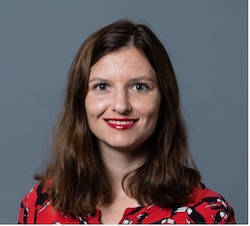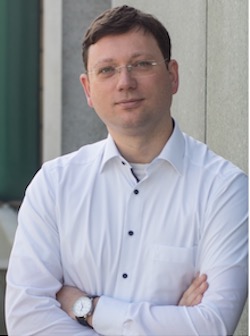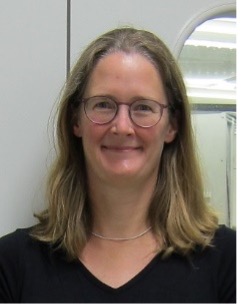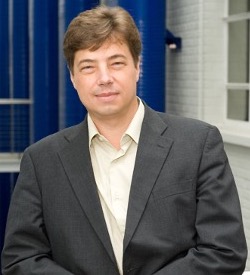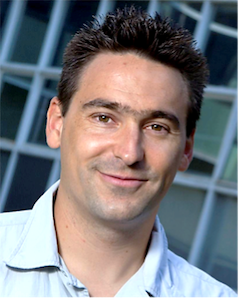
|
|
|
Lectures
Plasmons in unconventional materials probed by electron energy-loss spectroscopyHigh-resolution mapping of low-energy excitations such as plasmons, excitons, or phonons and their interaction is required for understanding and engineering the optical, electrical, or thermal properties of nanostructured materials. An unparalleled technique for analyzing the low-energy excitations down to the atomic scale is electron energy-loss spectroscopy (EELS) in a scanning transmission electron microscope (STEM), which enables the acquisition of spectra with a few-meV/Å spectral/spatial resolution. In the seminar, I will present two recent STEM-EELS studies of localized plasmons in nanoparticles made of unconventional materials: LaxBa1-xSnO3 (LBSO; a highly doped perovskite), and VO2 (a representative phase-changing material). In both cases, we use the broad spectral range provided by EELS to correlate the low-energy optical response with the information on the band gap and core-electron excitations. Our results reveal the relation between doping inhomogeneities in LBSO, its local band gap energies, and the emergence of non-trivial characteristics of the localized plasmonic modes. We perform STEM-EELS experiments with in-situ heating to understand the phase change and the related switching from a dielectric to a metallic state in VO2 at the single-nanoparticle level.
Nano-antennas married to microcavities for molecular optomechanicsThe lecture will show that the unprecedented degree to which nano-antennas can control directivity and rate of spontaneous emission is bounded by fundamental limits in spectral bandwidth and efficiency, which are a consequence of absorptive and scattering loss. In the seminar I will explore the fundamental tradeoff between spatial confinement and resonator quality factor, and I will show plasmonic-photonic hybrid structures that achieve quality factors between 300 and 1000, yet `plasmonic confinement’ volumes V, operating at (Q/V) ~ (λ3/106)-1. We achieve this in photonic nanobeam-plasmonic bow tie constructs, and also in the nanoparticle-on-mirror antenna system, acting as one mirror of a tuneable Fabry-Pérot microcavity. What is the physics of such plasmonic-photonic coupling, and how do you optimize it? What is unique in the performance metrics, and in which scenarios do you benefit? One such scenario is “molecular optomechanics”, which can be viewed as a conceptual extension of Surface Enhanced Raman Scattering (SERS). In SERS, nano-antennas are used to enhance inelastic vibrational scattering by molecules. Molecular optomechanics has promises beyond SERS, such as parametric cooling and amplification of molecular motion by light, or coherent transduction between visible light, molecular vibrations, and infrared light. These dreams are directly transposed from cavity optomechanics developed for GHz designer acoustic resonances, translated to molecular vibrations. Crucial to cavity optomechanics is socalled “sideband resolved operation”, wherein optical resonances must be much narrower than vibrational frequencies, so as to selectively couple light to vibrations, and selectively enhance only to Stokes or anti-Stokes scattering processes. I will show first sideband resolved SERS, demonstrating that sideband-resolved molecular optomechanics can be enabled by plasmonic-photonic hybrids. Gap-based plasmonicsUnder illumination, localized surface plasmon polaritons can be excited in metallic nanostructures that consequently act as antennas for visible light. Strong highly localized electric near-fields ensue at the nanoantenna surfaces. These fields can be further enhanced if the modes of two or more antennas couple across narrow gaps. This makes such systems attractive e.g. for sensing or surface-enhanced Raman spectroscopy [1]. Effects such as mode hybridization and spectral shifts are observed [2]. Since the shifts sensitively depend on the gap dimensions, such systems may be employed as so-called plasmon rulers [3]. The gap dependence can be particularly well investigated in nanoantennas on flexible substrates, where the coupling is continuously modified by applying strain [4]. Additional features may appear when antennas are arranged in regular arrays, where diffraction or far-field coupling of the antenna dipoles play a role [5]. Investigation of these processes crucially relies on the ability to prepare antenna structures in the intended sizes, shapes, materials, and arrangements. Here, nanofabrication has undergone tremendous progress over the last decades, allowing for ever better control over their properties. In this seminar, strategies for creating coupled plasmonic nanogap antennas based on different lithographic techniques and antenna configurations will be shown, with a special focus on reversibly tunable gap systems [6,7]. Simulations and measurements of the ensuing plasmon resonances, spectral properties, and enhancing capabilities will be discussed. References: [1] Y. Yang et al., Small 15, 1804177 (2019)[2] P. Nordlander et al., Nano Lett. 4(5), 899 (2004)[3] P. K. Jain et al., Nano Lett. 7(7), 2080 (2007)[4] F. Laible, M.F. et al., Adv. Opt. Mat. 9, 2100326 (2021)[5] V. G. Kravets et al., Chem. Rev. 118, 5912 (2018)[6] F. Laible, M.F. et al., Nanoscale 10, 14915 (2018)[7] W. Tao, M.F. et al., Nano Converg. 10, 15 (2023)
Au and Ag based nanostructures for bio(sensing) based on surface-enhanced Raman scattering.The novel field of Nanoplasmonics focuses on the manipulation of light using materials with significantly smaller sizes than the radiation wavelength. This is typically achieved using nanostructured metals since they can very efficiently absorb and scatter light due to their ability to support coherent oscillations of free (conduction) electrons. The great development of nanoplasmonics is based on fine control over the composition and morphology of nanostructured metals. Particularly, wet-chemical methods have the advantage of simplicity and large-scale production, while offering several parameters that could determine the final particle morphology and surface properties, which is essential for further applications. This seminar will provide an overview of the latest results of the FunNanoBio Group in the Nanoplasmonic field with special emphasis on the fabrication of plasmonic nanostructures for (bio)sensing based on surface-enhanced Raman scattering and localized surface plasmon resonance and catalysis.
Spin-orbit coupling and topology of plasmonic fieldsLight waves can carry both spin and angular optical momenta. Optical spin-orbit coupling describes how spin angular momentum of light, associated with circular polarisation of an electromagnetic wave, influences its extrinsic and intrinsic orbital angular momenta, associated with the propagation direction and energy flow, respectively. This coupling effect provides interesting applications in polarisation-enabled control of optical signals, or in reverse, controlling light polarisation, sensing applications, optical forces and quantum optical processes. In this talk, we will discuss spin-orbit coupling in surface plasmon polaritons and other guided waves with evanescent field components, its topological manifestations and applications. Topologically protected states in surface waves, and polarisation structure stability and transformations will be considered. The interaction between spin and optical angular momentum is important in controlling and tailoring the flow of light, especially on the nanoscale.
Metasurface system integration, from laser directional emission and spintronics to 3D imagingMetasurfaces are artificial optical interfaces designed to control the phase, the amplitude and the polarization of an optical wavefront. They use physical mechanisms that rely on the coherent scattering of light by nano-scatterers of various shapes and material compositions. In this seminar, i’ll present several on-chip integration of metasurfaces, including lasers, liDAR and detector arrays, and discuss how these innovative functionalities push the frontiers of optoelectronic systems beyond conventional devices. First, I will review our work on realization of directional light emission and collimation of VCSEL arrays and in particular on the spin-controlled laser emission[1,2]. We designed and experimentally validated CMOS compatible vectorial metasurfaces monolithically integrated with standard VCSELs for on-chip spin-decoupling and phase shaping. Taking advantages of metasurfaces polarization dependent response, we access the optical spin states of VCSELs. Exploiting spin states as a new degree of freedom for laser wavefront engineering, offers a simple and integrated solution to operate and read-out the spin-momentum of lasers associated with injected spin carriers, which would potentially play a pivotal role for the development of emerging spin-optoelectronic devices. I will then present new imaging capabilities provided by 3D LiDAR metasystem, emphasizing on the unprecended performances achieved, in terms of frame rate, field of view and the simultaneous acquisition of multiple field of views[3]. Finally i will present our results on 3D insect-inspired directional imaging devices. We show that mimicking the peripheral vision of insect using planar metalens arrays, we could measure simultaneously the light coming from several direction to reconstruct 3D images[4]. I will conclude this seminar by drawing perspectives and highlighting the opportuinities that this field of research still has to offer, both from fundamental and application point of views. References: [1] Nat. Nanotechnol. 15, 125–130 (2020). [2] Nat Commun 13, 7795 (2022).[3] Nat Commun 13, 5724 (2022).[4] submitted (2023)
Université Paris-Saclay, Institut d'Optique Graduate School, CNRS, Laboratoire Charles Fabry Palaiseau, France Light Emitting MetasurfacesIn order to shape a beam, a number of optical components have to be used. These include a source on the first place, a filter to control the spectrum, a polarizer and a retardation plate to control the polarization state and a lens to collimate the beam. Each component is bulky and has a transmission factor smaller than one. It is thus difficult to envision a lighting system within a micrometer thin device that could fit in any handheld device. Such an achievement can be done using light emitting metasurfaces. In this talk, we will remind what are metasurfaces and what can be achieved with them. Light emitting metasurfaces merge metasurfaces to control phase fronts and incoherent emitters emitting light by spontaneous emission. They are inherently different from passive metasurfaces as they are not illuminated by an incident coherent beam. We will discuss the operating principle of light emitting metasurfaces and their application to control the directivity, emission spectrum. Examples of metasurfaces emitting by incandescence and photoluminescence will be discussed. References: 1. L. Wojszvzyk, A. Nguyen, Anne-Lise Coutrot, C. Zhang, B. Vest, J.J. Greffet, An incandescent metasurface for quasimonochromatic polarized Mid-Wave Infrared emission modulated beyond 10 MHz, Nat. Commun 12, 1492 (2021).2. A. Nguyen, J.-P. Hugonin, A.-L. Coutrot, E. Garcia-Caurel, B. Vest, J.-J. Greffet, Large circular dichroism in the emission of an incandescent metasurface, Optica 10, 232 (2023).3. Hector Monin, Aurelian Loirette-Pelous, Eva de Leo, Aurelio A. Rossinelli, Ferry Prins, David J. Norris, Elise Bailly, Jean-Paul Hugonin, Benjamin Vest, Jean-Jacques Greffet, Controlling light emission by a thermalized ensemble of colloidal quantum dots with a metasurface, Opt. Express 31, 4851 (2023).
|
